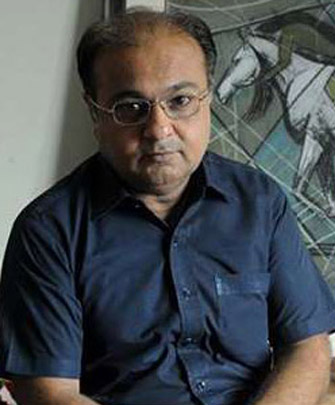Aamir Khattri

He is proud of his association with Eqbal Mehdi, a remarkable illustrator and artist renowned for his line etchings and paintings, Aamir Khatri is a textile designer by profession. He is perhaps one of the most prolific Pakistani painters, considering his extensive use of the social media, especially, The Facebook.
“Painting is my passion," says Aamir. "I feel proud when I paint, especially something to promote peace.”
Sanctity of the line and etching is a sacred trait that he got from the legendary painter Eqbal Mehdi. It was back in 1984-86 that Eqbal Mehdi guided Aamir Khatri. "It was Iqbal Mehdi who infused life in my art," he admits.
He wanted to go to an art school but early death of his father deprived him of that pleasure. He began earn his daily bread through graphic designing of garment labels. A friend introduced him to Eqbal Mehdi to whom he showed his work on wildlife. He fancied tigers and so Iqbal Mehdi advised him to draw tigers and make that his forte.
Aamir liked to do water color. He experimented with portraiture, landscaping, abstract and impressionism but wildlife has been his favorite subject.
As a junior artist he participated in a number of groups shows at many renowned art galleries. "A message through confession" (1997) was his first solo exhibition. His first exhibition at the Art Council, Karachi, was held at the behest of Iqbal Mehdi in 1986. Then his work was displayed at Pakistan National Council of Arts, Islamabad, followed by Galerie Sadequain, Karachi, Art Collectors Gallery, Karachi. The latest one was at held at Grandeur Art Gallery in September 2012.
Aamir Khatri, born 1968, did his first drawing, using the card cover of a notebook as the canvas when he was only three years old. He is a keen observer of human feelings and behavior and uses this talent profusely in his art. “When I really started painting, I did have soft feelings for human misery but I was too naïve. I must say that my naiveté that pushed me to do art. My childhood was not a happy one but not too miserable either. I still have my childhood image of my mother. I can vividly recall that she did such a lot for us, like all good mothers do; but I think she did much more than was in her power. She went an extra mile to make me happy.”
He wanted to see this world a happy place where there is no hate, no jealousy, no envy, no wars, no weapons, no theft or robbery, no kidnappings, no bribes, no evil and no wrong feelings.
“I wished and prayed that this world would be a place where no one would go hungry and everyone had clothing to dress clean, everybody abided by the law, and everyone would be happy, where human beings lived with love and where human beings had equal rights; where every child could get good education and where everybody had positive thoughts and feeling for everyone else.”
The biggest achievement of his life, as he believes, “is that people know me for my mission of peace and humanity. Secondly I have my own style of creating art and now it is my identity.”
He works for export industry as a senior textile designer for prints and woven jacquard fabrics. “I want to do work a lot as a full-time artist but unfortunately as the conditions in this country are not conducive to having fine art a career and a profession, I earn my bread and butter from working as a textile designer. I want to do something for widows and orphans. I have a lot of plans and ideas but I am waiting for my dreams to come true.
Long time back, his method of painting with water color was interesting. He would soak the sheet in water, allows it to dry a little. Then he quickly applied the pigments and finished it off before it dried up. In this way, he created the required tint. Cotton swabs and brushes used to be his basic tools.
Aamir liked to do water color. He experimented with portraiture, landscaping, abstract and impressionism but wildlife has been his favorite subject.
As a junior artist he participated in a number of group shows at many renowned art galleries. His first exhibition at Art Council, Karachi, was held at the behest of Iqbal Mehdi in 1986, followed by Pakistan National Council of Arts, Islamabad, Galerie Sadequain, Karachi, Art Collectors Gallery, Karachi, and several other galleries. Now it was at Grandeur Art Gallery.
His method of painting with water color was interesting. He would soak the sheet in water, allows it to dry a little. Then he quickly applied the pigments and finished it off before it dried up. In this way, he created the required tint. Cotton swabs and brushes used to be his basic tools.
Now he works with oil paint, combining abstract and impressionism. So obviously, his oils show emotional restlessness mingled with mental distortion of humanity in all walks of life.
His art series 'Thirst for Peace' constitutes a universal message of peace for all human beings.
Written by Khalid Rahman. (Nigaah Art)

